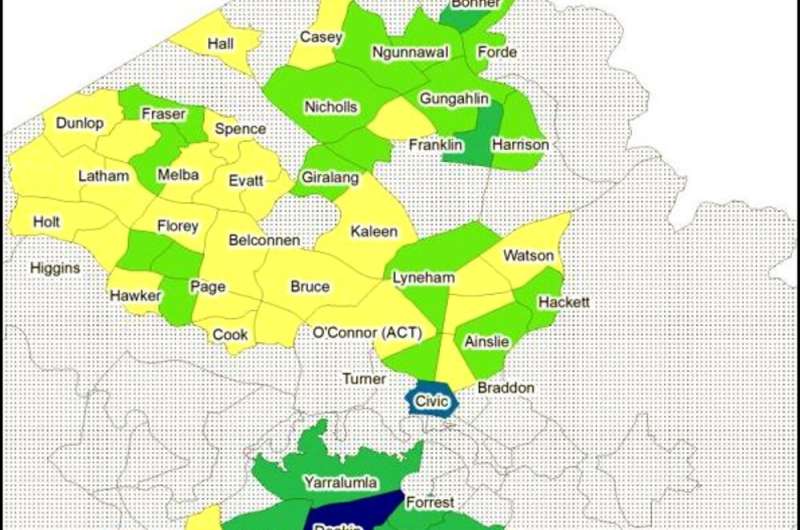What would it take to get Australians to buy electric cars? Canberra provides a guide
by Yogi Vidyattama, Darren Sinclair, Jacki Schirmer and Robert Tanton, The Conversation

Only 5,532 of the 101,233 new cars sold in Australia last month were all-electric.
While that number is an improvement on previous months, it is tiny compared to the 25% to 85% of new cars sold that are all-electric in European nations such as Germany, the Netherlands, Denmark and Norway.
A lot has been written about why that is, but less about what an individual state or territory can do to improve it, in the absence of help from the federal government.
Our team at the National Centre for Social and Economic Modelling, University of Canberra has examined what the Australian Capital Territory (ACT) is doing, and what effect this is having on electric vehicle take-up by price and type of household.
The ACT offers three incentives
- a full exemption from stamp duty on purchase
- two years free registration
- a zero-interest loan of up to A$15,000 for eligible households
We used Australian Bureau of Statistics census and household expenditure data as well as microsimulations based on a survey of vehicle preferences to examine behaviour before and after the changes.
We simulated the decision to buy electric based on a total cost of ownership, which included the value of the vehicle as well as operational costs including petrol, service and repair.
Incentives matter
Our modelling found that with a stamp duty exemption, at an electric vehicle price of A$50,000, around 9% of new vehicles sold would be electric in five years.
The proportion climbs to 11% with zero-interest loan and free registration added.
But even after five years, the proportion of total cars on ACT roads that were electric would be small: just 1.6% with just the stamp duty exemption, and 2.0% with the other measures as well.
This result is much higher than the latest-known proportion of electric vehicles in the ACT, which in 2019 was 0.1%. Nationally, only 23,000 (0.011%) of the 20.1 million vehicles registered are electric.
Prices matter
At a much-lower electric vehicle price of $25,000, an extraordinary 23% of new vehicles sold after five years would be electric, provided they were stamp duty exempt.
If there was also a zero-interest loan of $15,000, the proportion would increase to 27%, and with two years free registration as well, to $30%.
As a proportion of the entire car fleet in the ACT, the figures would be 4.1%, 4.8% and 5.3% respectively, depending on those price, loan and registration factors. That would mean much larger demand than at present, but still small enough to mean the infrastructure for maintaining conventional vehicles would be needed for some time.
Income matters
We found that high income households are far more likely to replace their cars within five years and far more likely to switch electric even without incentives—and that for them, the incentives didn’t make much difference.
The incentives had their biggest impact, not among the highest earning three-fifths of households, or among the bottom fifth, but in the second-bottom fifth.
For that group, the interest-free loan was found to be more important than the free registration, whereas for higher income households it was the other way around.
In terms of geography, the highest take up is set to be in Canberra’s inner north and south where incomes are high. Nevertheless, our modelling also suggests a high take up in the south of Canberra.
Petrol matters
And the take-up rate depends on the price of petrol. The price used in our modelling was the 2018-19 price of around $1.45 per litre for unleaded and diesel.
Our modelling suggests that the recent increase in price to around $2 a litre would lift the purchase of electric vehicles by 0.5 percentage points, while an increase to $3 would increase take-up by around 2.5 percentage points.
Different states are experimenting with different incentives. Victoria, NSW and Queensland are offering $3,000 rebates on the purchase price, along with a registration discounts in Victoria offset by a road user charge.
What applies to the ACT might not apply elsewhere, especially as average incomes in Canberra are higher than in other cities. But our modelling provides a guide as to how incentive-based policies can work.
Policies that increase the electric vehicle take-up in lower income households are likely to have the greatest effect, and also likely to benefit these households by freeing them from the need to pay for fuel.
Hertz to buy up to 65,000 electric vehicles from Polestar
This article is republished from The Conversation under a Creative Commons license. Read the original article.![]()
Citation:
What would it take to get Australians to buy electric cars? Canberra provides a guide (2022, April 8)
retrieved 8 April 2022
from https://techxplore.com/news/2022-04-australians-electric-cars-canberra.html
This document is subject to copyright. Apart from any fair dealing for the purpose of private study or research, no
part may be reproduced without the written permission. The content is provided for information purposes only.
For all the latest Technology News Click Here
For the latest news and updates, follow us on Google News.

